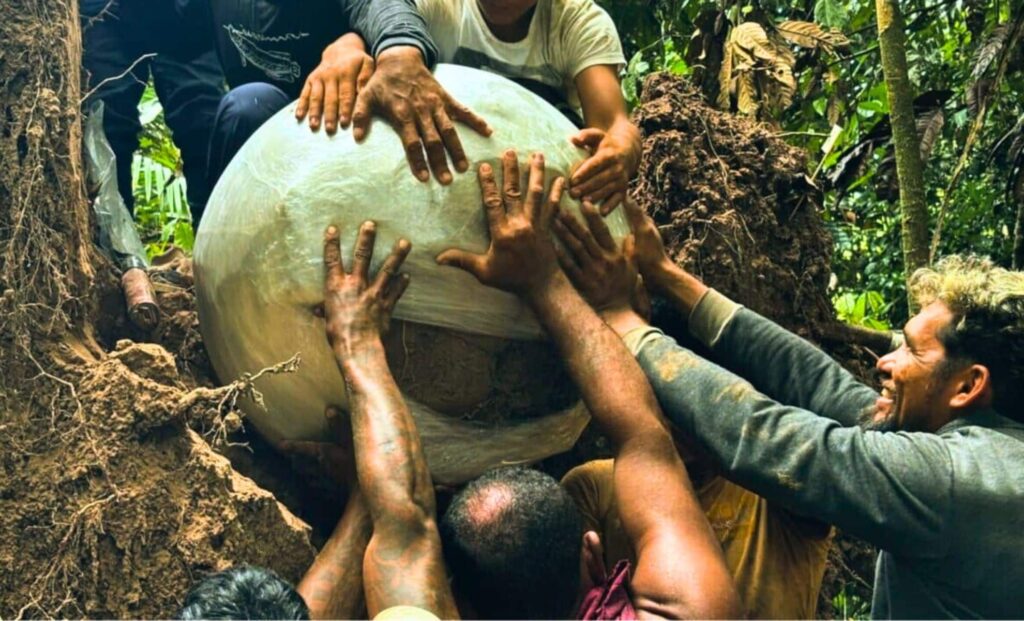In a remote floodplain of the Brazilian Amazon, where the Solimões River quietly redraws the landscape with each rainy season, an uprooted tree has exposed something few thought still lay hidden beneath centuries of silt and soil: seven large ceramic urns, buried just beneath the surface on an artificial island. Inside the sealed vessels, archaeologists found an unlikely mix—human bones, turtle shells, and fish remains—interred together in a way that has no clear precedent in the archaeological record of the region.
The discovery, made in Fonte Boa, in Brazil’s Amazonas state, is prompting archaeologists to rethink long-held assumptions about Indigenous funerary practices in the rainforest. While human remains buried in urns are not new to the Amazon, the inclusion of aquatic animals typically associated with food points to a potentially complex ritual logic—one that may have symbolically connected death and nourishment.

According to a detailed announcement by the Brazilian Ministry of Science, Technology and Innovation, the urns were uncovered on a man-made mound in a flood-prone area near Lago do Cochila, a site now recognized as part of a larger network of artificial islands. These elevated landforms, built from earth, ceramic shards, and organic debris, allowed ancient populations to establish stable settlements above the seasonal floodwaters—a form of Indigenous engineering that challenges earlier models of Amazonian life as transient or semi-nomadic.
A Vanished Style and a Hidden System
Archaeologists from the Mamirauá Institute for Sustainable Development are leading the analysis of the urns, which appear to reflect a ceramic tradition previously undocumented in the region. The vessels were crafted from rare greenish clay and show surface treatments like red slip bands and engobe coatings, but do not match known ceramic styles such as the widely studied Amazon Polychrome Tradition.
Dr. Geórgea Layla Holanda, one of the lead researchers, noted that the urns’ materials and designs suggest a distinct cultural group, whose mortuary customs incorporated animals in ways not yet fully understood. The urns had no visible ceramic lids, suggesting they were likely sealed with organic materials that have long since decayed. They were found buried just 40 centimeters below the surface, possibly beneath what were once domestic structures, further supporting the idea that daily life and death were spatially and symbolically intertwined.


The excavation, led by archaeologist Márcio Amaral, took place under unusual circumstances. The urns had been lifted into the air—over three meters off the ground—by the roots of the fallen tree. Without access to heavy machinery, community members built a scaffold using local wood and vines, allowing the researchers to safely retrieve the vessels.
Engineered Landscapes, Enduring Legacies
Such artificial islands are not isolated anomalies. A 2020 study published in PNAS detailed how pre-Columbian societies across the Upper Amazon constructed mound systems and settlement grids, shaping their landscapes with remarkable foresight. These earthworks often served multiple purposes: housing, agriculture, ceremonial use, and protection from floods. The research concluded that these societies were far more complex and sedentary than once believed, with a profound understanding of how to manipulate and coexist with seasonal hydrological cycles.
The discovery in Fonte Boa adds weight to that theory. These were not isolated individuals moving through the forest—they were communities with territorial planning, ritual frameworks, and architectural intent. The logistics of building such mounds in remote, flood-prone environments—and using them as permanent living space—underscore a level of sophistication that researchers are only now beginning to map systematically.


This particular find also highlights the value of community-led science. It was a local fisherman, Walfredo Cerqueira, who first reported the discovery after noticing shards of pottery among the roots of the toppled tree. From there, the chain of communication—from local priest to regional researchers—illustrates a model of collaborative archaeology that blends scientific inquiry with traditional ecological knowledge.
Ritual Meanings Still Emerging
What remains unresolved is the exact purpose of the mixed remains found inside the urns. Some experts speculate they may represent ritual offerings, where food—fish and turtles—was interred alongside the dead as sustenance for the afterlife, or as symbolic guardians. Others see potential connections to Andean mortuary practices, where nourishment and rebirth were often linked in cosmological terms. But there is, as yet, no definitive interpretation.
For now, the urns are undergoing further laboratory analysis in Tefé. Researchers are conducting material studies, stratigraphic mapping, and radiocarbon dating to better understand the chronology and function of the site. Initial indications suggest the urns may date back centuries, if not over a thousand years.

